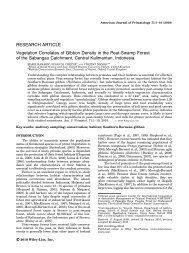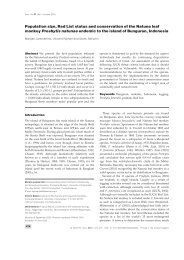Seasonal variation in naturally occurring mobbing ... - Vincent Nijman
Seasonal variation in naturally occurring mobbing ... - Vincent Nijman
Seasonal variation in naturally occurring mobbing ... - Vincent Nijman
Create successful ePaper yourself
Turn your PDF publications into a flip-book with our unique Google optimized e-Paper software.
Mobb<strong>in</strong>g <strong>in</strong> drongos<br />
29<br />
m<strong>in</strong>utes by two black drongos. Attacks ranged from short s<strong>in</strong>gle strikes with a<br />
duration of only a few seconds, to a series of repetitive attacks last<strong>in</strong>g up to five<br />
m<strong>in</strong>utes.<br />
Black eagles were not more frequently attacked than Javan hawk-eagles (G adj<br />
= 0.3, df = 1, P = 0.60). Duration of attacks (short, medium, long) did not differ<br />
between the two species of eagle (Mann-Whitney U, N 1 = 8, N 2 = 12, P = 0.93), nor<br />
did the two eagles differ significantly <strong>in</strong> their response to the attack (Mann-<br />
Whitney U, N 1 = 6, N 2 = 11, P = 0.28). Thus the prediction that black eagles should<br />
be more frequently or more vigorously attacked is not supported by the data.<br />
<strong>Seasonal</strong> <strong>variation</strong> <strong>in</strong> mobb<strong>in</strong>g behaviour by drongos<br />
Comb<strong>in</strong><strong>in</strong>g data from both eagles, no association between mobb<strong>in</strong>g and season<br />
was apparent (G adj = 0.3, df = 1, P = 0.60). There is however a significant seasonal<br />
difference between the two species <strong>in</strong> the number of attacks received (Fig. 2:<br />
G adj = 5.6, df = 1, P = 0.018). The black eagle tended to be more frequently mobbed<br />
dur<strong>in</strong>g the non-breed<strong>in</strong>g season than dur<strong>in</strong>g the breed<strong>in</strong>g season of drongos (8<br />
attacks dur<strong>in</strong>g 44 observation hours vs 2 attacks dur<strong>in</strong>g 37 observation hours), but<br />
the difference is not significant (G adj = 2.5, df = 1, P = 0.11). For the Javan hawkeagle<br />
significantly more attacks were documented dur<strong>in</strong>g the breed<strong>in</strong>g season (15<br />
attacks dur<strong>in</strong>g 73 observation hours) compared to the non-breed<strong>in</strong>g season (2<br />
attacks dur<strong>in</strong>g 36 observation hours) (G adj = 4.0, df = 1, P = 0.045).<br />
The <strong>in</strong>tensity of the attacks measured directly by its duration did not differ<br />
with season (Mann-Whitney U, N 1 = 2, N 2 = 10, P = 0.19 and N 1 = 4, N 2 = 6, P =<br />
8<br />
Attacks per 30 hr<br />
Javan Hawk-eagle<br />
Black Eagle<br />
6<br />
4<br />
2<br />
0<br />
Breed<strong>in</strong>g Season<br />
Non-Breed<strong>in</strong>g Season<br />
Fig. 2. — <strong>Seasonal</strong> differences <strong>in</strong> mobb<strong>in</strong>g <strong>in</strong>tensity by drongos towards two avian predators (Javan<br />
hawk-eagle Spizaetus bartelsi and black eagle Ict<strong>in</strong>aetus malayensis) as <strong>in</strong>dicated by the number of<br />
attacks per 30 hr of observation.










